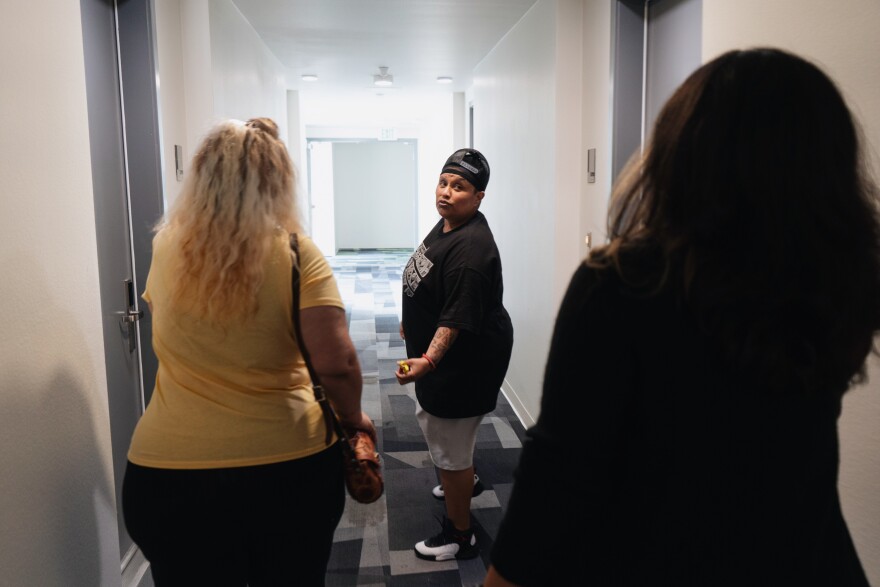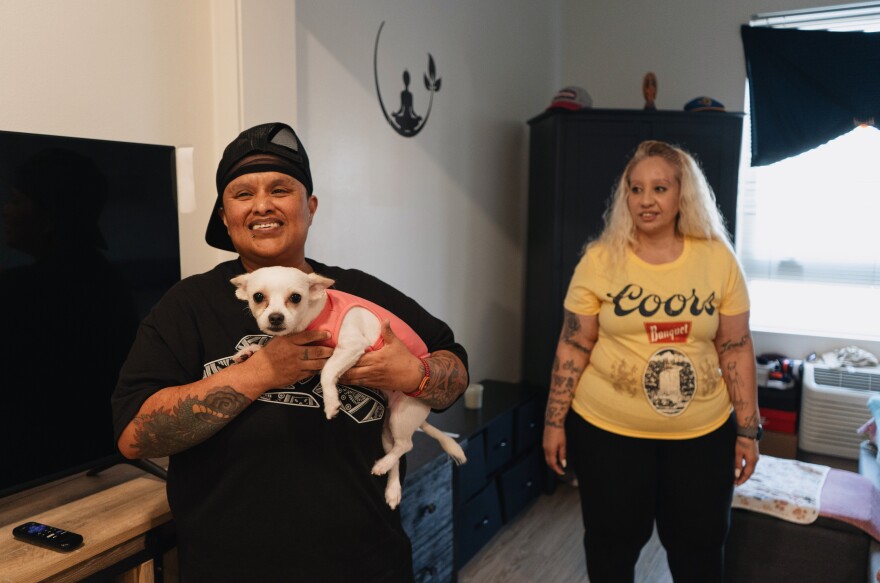When a stranger called offering Dulce Volantin some financial help, she was skeptical.
"Sounds kind of shady," she recalls thinking.
At the time, Volantin and her partner, Valarie Zayas, were renting a bed at a place on Venice Beach in Los Angeles. "Dormitory-style living," Zayas says. The women had met in prison a few years before, after each had been involved with gangs, and they were over-the-moon happy to have found love. But Volantin had suffered bad bouts of mental illness that required hospitalization. Zayas was hustling temp jobs to supplement Dulce's disability aid.
They'd slept in their car, then lost it. Stayed with family for too long. Then started donating plasma and selling some of their clothes to pay for motels. "By the seventh day, you don't have anything in your pocket no more," Volantin says.
Despite her doubts, she returned that phone call — and it turned out to be not only for real, but also life changing.

The call was from the Los Angeles County Department of Health Services, part of a first-of-its-kind experiment to try and curb homelessness numbers, which keep going up despite massive spending. On average, for every 207 Angelenos who exit homelessness every day, 227 others fall into it.
Loading...
Los Angeles is housing more people than ever, and building lots more low-income housing, yet it can't keep pace with this ever-rising number of people who end up in cars, tents and shelters.
"It's a bucket with a hole in it, so we've got to do something ... to fill that hole," says Dana Vanderford, who helps lead the department's Homelessness Prevention unit.
With that goal, the pilot program is using artificial intelligence to predict who's most likely to land on the streets, so the county can step in to offer help before that happens.

The program tracks data from seven county agencies, including emergency room visits, crisis care for mental health, substance abuse disorder diagnosis, arrests and sign-ups for public benefits like food aid. Then, using machine learning, it comes up with a list of people considered most at-risk for losing their homes. Vanderford says these people aren't part of any other prevention programs.
"We have clients who have understandable mistrust of systems," she says. They've "experienced generational trauma. Our clients are extremely unlikely to reach out for help."
Instead, 16 case managers divide up the lists and reach out to the people on them, sending letters and cold calling.
It's surprisingly hard to offer people thousands of dollars over the phone

Sitting in a spare office one recent morning with her laptop and cellphone, case manager Elizabeth Juarez starts dialing. A major challenge is that the county never reaches half the people on its lists. Juarez says when people's lives are unstable their numbers and addresses often change. When she does get through, some people are facing eviction or dealing with domestic violence. Every now and then she'll reach a person who's already lost their housing, so then she has to tell them that they no longer qualify for the prevention program.

Some actually decline the help, telling her others need it more. And then there are the skeptics. "They kind of just give you the runaround," Juarez says. "Maybe they're not trusting, and I totally understand." She'll call back a couple times just in case they come around.
On this morning, though, it isn't long before Juarez gets someone on the phone. She is cheerful and patient with the man, knowing it can take a minute to process what's happening. She explains how the program offers a case manager to work with people for four to six months. They'll help figure out how to spend $4,000 to $6,000 dollars in aid, money which he won't have to pay back.
"Straight to a bank account?" the man asks. No, Juarez explains, it goes to third-party vendors to cover bills like rent, utilities, groceries or other monthly expenses. She tells him the main reason is to avoid jeopardizing any public benefits that might be cut if someone's income increases.
The man mentions he's renting from a relative and recently had a seizure. Yes, he says, he'd like to sign up.
While most people need rent help, Juarez says that's not always the most urgent problem. She's used the allocated money for payday loan debt, appliances, laptops and, recently, an e-bike for someone whose mental illness made it difficult to take public transportation.
"We discuss, 'How is your living situation?' '' she says. "So while somebody might be physically housed, is it safe in there? Do you have a bed? Do you have what you need in your home to thrive and feel stable?"
A sudden death pushes a retired grandfather's finances over the edge
Ricky Brown is a new client in the prevention program. The 65-year-old was a handyman but went on disability after injuring his back when he was in his 40s. He was barely getting by in a one-bedroom apartment in L.A.'s Crenshaw neighborhood, making ends meet on his income from Social Security and odd jobs. Then his ex-wife died suddenly a year ago. She'd been raising their three grandsons, because Brown's daughter and her husband are addicted to pills. Now, he's taken in the boys and it's been a financial blow.
"I had a little money put away, but boy ... I went through it," he says. "Because these kids eat."
On a recent morning, county case manager Fred Theus visits to work out a plan. They sit in Brown's living room, where there are now bunk beds for the three boys and large plastic bins overflowing with their clothes and sneakers. 11-year-old Ziare is hanging out with his phone while his brothers are at after-school homework time.

Theus ticks off a list of needs: car repairs, paying back due rent and utilities, restoring food aid for the boys. They were cut off a year ago, though Brown has no idea why. Theus guesses it may have been a paperwork snafu.
Then the biggest challenge: Brown is desperate to find a two-bedroom place for the boys. "They want to play," he says. "They want open space and they can't get it."
Theus says it will be difficult to find anywhere Brown can afford, so they'll have to try for a housing voucher to bring down his expenses. That, combined with boosting his income through food stamps and cash aid, are the best hope for making him self-sufficient.

"That's our main goal," Theus says, "to make sure they are able to take care of themselves after we're done."
But there aren't nearly enough federal housing vouchers to meet the need, and Theus says wait times have gotten longer as cities try to help the growing number of people who are unhoused. Even scoring a voucher is no guarantee. In fact, Brown had one a decade ago, but he had to move when that building was sold. He wasn't able to find another landlord willing to accept the voucher before the time to use it ran out.
Brown says he's been blessed with this program and calls Theus a "lifesaver." But at night, it doesn't keep his mind from racing with a thousand worries.
"I might have to lose [the boys]," he thinks. "Or, you know, we're going to be on the street. That's the main thing I think about is the street. ... I stay worried about a lot of stuff every day."
It's not clear yet whether this experiment can keep people housed long term

In just over two years L.A.'s pilot prevention program has worked with 560 people. Data shows a large majority have stayed housed so far, but the program is conducting a more formal long term study. It includes a randomized control trial that's tracking people with similar needs who do not receive assistance.
Key questions are whether a few months of help and a few thousand dollars can make a lasting difference. And whether they are targeting the right people, meaning those who would actually end up on the streets but for this intervention.
"For example, here in Los Angeles, you might have 2 million people on public assistance, all of whom seem vulnerable. But only 1% to 2% of them will ever experience homelessness," says Janey Rountree, executive director of the California Policy Lab at UCLA, which developed the program's AI prediction tool.
Rountree expects to publish the study results in 2026, which is also when the program's funding runs out; most of its $31 million budget came from pandemic aid. She hopes there will be a strong case that it should be scaled up, and can be a model. In fact, San Diego County has already voted to create its own similar program using predictive analytics.
Loading...
Depending on its long-term results, Los Angeles' proactive approach could add much needed evidence for what works to prevent homelessness, says Beth Shinn, an expert on the issue at Vanderbilt University and also an adviser to the L.A. program.
"Much of the public equates eviction prevention with homelessness prevention," she says. But while being evicted can certainly have devastating consequences, Shinn says research has not linked it to a significant rise in unsheltered homelessness. She says housing vouchers have shown the strongest success for keeping people housed, at least for families. A small-scale prevention program in New York City has also had good results.
But Shinn says the analytics driving Los Angeles' program are targeting people at much higher risk for losing housing. "You may have more failures there," she says, but the reward could also be greater. "You make the most difference for the people who are at highest risk."
An out-of-the-blue phone call that meant "the world"

When asked what this program has meant for her and her partner, Dulce Volantin chokes up as she says, "The world, the world." After months of searching with their case manager, the two women were lucky to get accepted at a subsidized apartment building with on-site case management for Volantin's mental health needs.
When they enter the door to show visitors, their little dog Zoey yaps in excitement. It's a cozy space with family photos and inspirational quotes on the walls. "Slowly but surely we started decorating the place, cause it came furnished," Volantin says.

Valarie Zayas says the newfound stability helped her land a good job with the transit system. "I have a clear head" she says. "I don't have to worry about where our next meal is going to come from."
Across the street from their building is a park where people spend days on the green lawn and sleep in tents. Volantin says it hurts her heart to see.
"We give them whatever we have in our pockets, food, anything that we could, because we know the situation," she says. "We could have had one bad step and we would have been right there."
Copyright 2023 NPR. To see more, visit https://www.npr.org.




